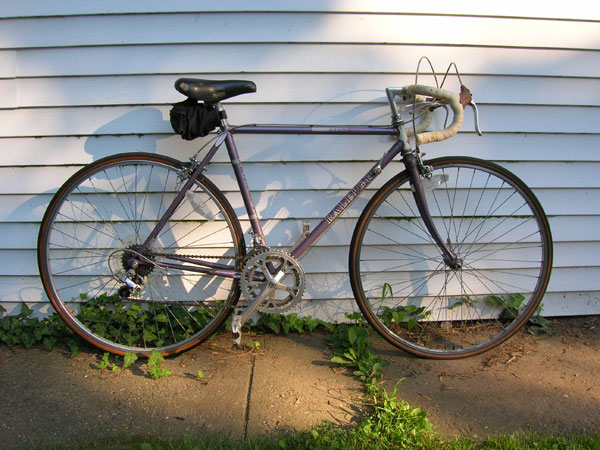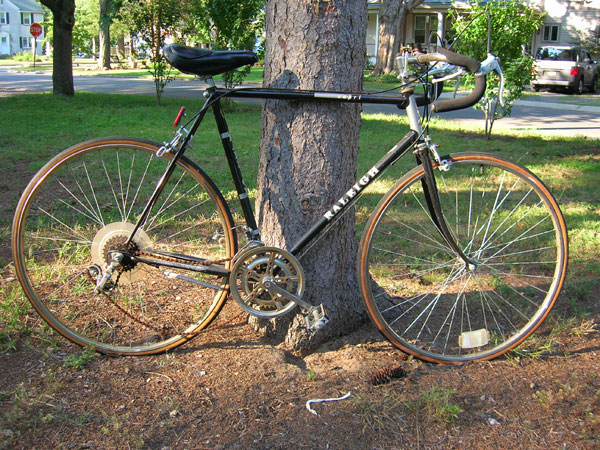Flashback: Tips for bike scrounging


Above: An old ten-speed with a rusty chain and a few missing parts. A perfect project bike for personal use or for donation. Below: A reincarnated Raleigh road bike ready to ride for many miles.
Abandoned, neglected bikes are by no means a rare sight. Seeing one sticking out of the bushes behind our parking lot made me think of Thomas Arey’s “Bike Scrounging” article from MAKE Volume 12. Thomas offers up some great tips and resources on how to recover discarded rides and even donate them. Here’s the full article for you.
Bike Scrounging
How to fix a castoff bike and give it away.
By Thomas Arey
I’m going to venture a guess that many makers’ earliest experiences working with tools and trying to figure out machines involved a bicycle. Even today it’s the rare kid who hasn’t tried to fix or even modify their bike. It’s one of the reasons I still have great hope for humanity.
Cycling is good basic transportation, a boon to the cardiovascular system, and most of all, fun! But have you ever considered that cycling can also be free?
In the course of the trash picking and dumpster diving I do to bring these occasional articles to MAKE, I often run across bicycles left at the curb with other signs of our society’s tendency to toss away what might be repaired or repurposed.
I’ve taken many of these rejected rides, turned them back into working bicycles, and donated them, either locally or through service organizations, to folks whose lives can literally be changed by owning a bicycle.
My general experience shows that the parts from 2 or 3 disposed bikes can make for 1 good bike. Any leftover parts from each scrounging venture go into storage to support future bike recovery operations.
Bicycle recovery is the perfect “learn by doing” process. Beyond stripping some threads (also repairable) you can’t really hurt anything. Mixing and matching parts from different bikes will make you more adept at repair. This can even turn into a marketable skill with enough practice. Good bicycle mechanics are hard to find.
Your public library and the internet will turn up dozens of books and websites to help you get beyond the basics quickly. A good book that covers just about everything you need to know and more is The Bicycling Guide to Complete Bicycle Maintenance and Repair: For Road and Mountain Bikes by Todd Downs.
Sheldon Brown (sheldonbrown.com) is a well-known cycle mechanic who shares tons of information free on the web. A good source for odd and hard-to-find parts is Loose Screws (loosescrews.com).
Older bikes and most consumer-grade cycles can be worked on with common hand tools. The only specialty tool you may need from the start is a chain tool, required to remove and replace the chain on most multigear bikes. This tool can be found for as little as $10, but if you plan to do this a lot you should invest in high-quality tools.
When you come upon a bike leaning against a trash can, don’t assume it’s being trashed. I always knock on the door and check. More often than not I hear, “I got a couple more around back, you want them, too?”
When you get your bike(s) home, go through these steps:
1. Check your find over. Why was this bike tossed? I am always surprised to find that a few small problems led to the trip to the curb: a flat tire, snapped brake cable, or rusted chain being the most common.
2. Once you fix up the obvious problems, go over every nut, bolt, and bearing to tighten things up and check for more subtle problems that may require further disassembly.
3. In most cases, if it moves, lubricate it! Extremely neglected bikes may require greasing the bearings, but a little chain oil will get most bikes back on
the road.
4. Replace bad or worn parts with other items from your trash-picking efforts. Get friendly with your local bike shop. They have trash bins, too!
5. Even if the tires inflate, check both tires and tubes for signs of dry rot. Well-cared-for tires can last a long time but this may be the one place you need to spend money.
6. Broken spokes and bent wheels are intermediate-level repairs. Until you master the skills for this task just keep an eye out for other good wheels on your scrounging route.
7. Double-check all matters of safety, especially the braking system.
8. Enjoy the ride. It may be a little rough and rusty, but it rolls and the price is right!
After you’ve built a bike or two for your personal needs, why not think of getting your rebuilds into the hands of folks who can use them? Check your local social-service and faith-based organizations.
If you want your bikes to go beyond your local neighborhood to help the world, one clearinghouse website for bike donation is the International Bike Fund’s page at ibike.org/encouragement/freebike.htm. This site lists organizations throughout the United States and other countries, and includes details about how your efforts to repair and reincarnate castaway cycles can truly work to change the world.
You can still pick up a back issue of MAKE Volume 12 in the Maker Shed.

Read more | Permalink | Comments |